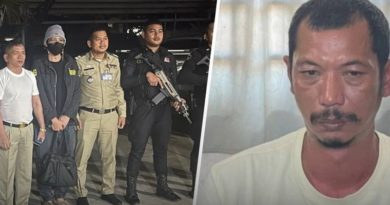Test shows North Korea missile could hit LA, Chicago
(CNN) – North Korea tested an intercontinental ballistic missile yesterday (July 28) that appears to have the range to hit major US cities, experts say.
A combination of US, South Korean and Japanese analyses of the launch from Mupyong-ni, near North Korea’s border with China, show the missile flew about 45 minutes, going 3,700 kilometers (2,300 miles) high and for a distance of 1,000 kilometers (621 miles).
If the missile were fired on a a flatter, standard trajectory, it would have major US cities like Los Angeles, Denver and Chicago well within its range, with possibly the ability to reach as far as New York City and Boston, according to David Wright, a missile expert at the Union of Concerned Scientists.

South Korea’s joint chiefs of staff said they estimate that the intercontinental ballistic missile tested yesterday is more advanced than one launched earlier this month based on the range it traveled. Experts had said that test showed Pyongyang had the ability to hit Alaska.
Wright said that early analysis of yesterday’s test cannot, however, determine how heavy a payload the missile was carrying in its warhead. The heavier the payload, the shorter the range, he wrote on his organization’s website.
A statement from Pyongyang’s state-run Korean Central News Agency today said the latest missile launch was a Hwasong-14, the same missile tested earlier in the month.
Yesterday’s test was designed to show the Hwasong-14’s maximum range with a “large-sized heavy nuclear warhead,” the statement said.
It said Washington should regard the launch as a “grave warning.”
US President Donald Trump condemned North Korea’s launch yesterday.
“Threatening the world, these weapons and tests further isolate North Korea, weaken its economy, and deprive its people.” Trump said in a written statement. “The United States will take all necessary steps to ensure the security of the American homeland and protect our allies in the region.”
The chairman of the Joint Chiefs of Staff, Gen. Joseph F. Dunford, Jr., and the commander of US Pacific Command, Adm. Harry Harris, called the South Korean Joint Chiefs of Staff Chairman General Lee Sun Jin in the wake of North Korea’s test to express the US’ “ironclad commitment” to its alliance with South Korea and discuss military response options.
Hours after that call, the US and South Korean military conducted a live fire exercise as a show of force in response to the missile test, according to Pentagon spokesman, Capt. Jeff Davis. The exercise included firing missiles into the ocean.
Both militaries conducted a similar show of force, after North Korea’s first ICBM test in early July.
China, a longtime North Korean ally, issued a statement today condemning yesterday’s missile launch and asked Pyongyang to “stop taking actions that would escalate tensions” on the Korean Peninsula.
“The UN Security Council has clear regulations on North Korea’s launch activities that use ballistic missile technologies. China is opposed to North Korea’s launch activities in violation of UN Security Council resolutions and against the will of the international community,” a statement from Chinese Foreign Ministry spokesman Geng Shuang said.
Beijing’s statement reiterated its long-held position on North Korea’s missile program.
US Secretary of State Rex Tillerson said China and Russia need to do more to stop North Korea’s missile program.
“As the principal economic enablers of North Korea’s nuclear weapon and ballistic missile development program, China and Russia bear unique and special responsibility for this growing threat to regional and global stability,” Tillerson said in a statement.
After speaking with Tillerson today, Japanese Foreign Minister Fumio Kishida said Tokyo would join Washington in new appeals to China and Russia to stop North Korea’s missile program.
2017 has been a year of rapid progress for North Korea’s missile program.
Pyongyang has carried out 12 missile tests since February and conducted its first-ever test of an ICBM on July 4 – which it claims could reach “anywhere in the world.”
“North Korea will continue to test over and over again its missile technology and nuclear weapons in the months and years to come in order to develop the most lethal systems it can,” Kazianis said. “You can bet every time they do tensions will continue to rise. This is what makes the situation on the Korean Peninsula as dangerous as it is.”
Less than six years into his reign, Kim Jong Un has tested more missiles than his father and grandfather combined.
North Korea’s latest test has spurred calls for a response from the Trump administration.
“North Korea’s latest missile test shows the Trump administration’s actions are not changing North Korea’s behavior and it’s time for the President to articulate a comprehensive strategy to the American people – so far he’s failed to do that,” Democratic Rep. Ted Lieu told CNN yesterday.
Trump administration officials have warned that “all options are on the table” but a clear path forward has yet to materialize.
Doug Bandow, a senior fellow at the Cato Institute who specializes in foreign policy, told CNN that North Korea’s missile launch shows Pyongyang is “absolutely committed to their missile programs” and not interested in tempering their activities.
Bandow, who visited North Korea just last month, said the regime is convinced that developing its missile program as a nuclear deterrent is absolutely necessary. This, he said, is a mindset that continues to put pressure on Trump, who finds himself in a situation with no good choices.
Those choices are further complicated by the unpredictable nature of Kim Jong Un, according to Lieu, who also told CNN he “does not know” if Kim would be willing to use a long-range nuclear weapon should he acquire that capability.
CAPTION:
Top and inset: Photos taken from Korean Central Television show the activity around North Korea’s intercontinental ballistic missile launch late yesterday. Photo: CNN
SOURCE: CNN written by Brad Lendon with Zachary Cohen, Barbara Starr, Junko Ogura, Steven Jiang, Taehoon Lee and KJ Kwon contributing to this report.



